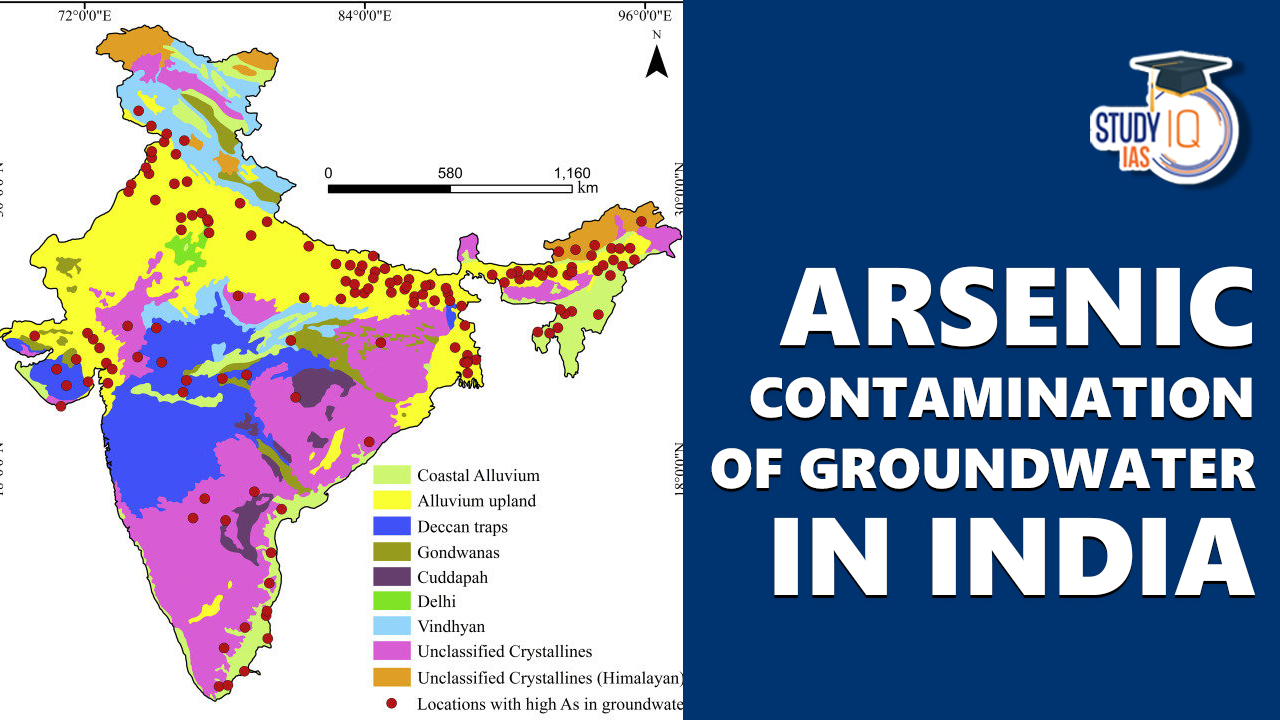Table of Contents
Context: High arsenic concentration has been found in groundwater in 18 districts of Bihar, as well as its correlation with incidences of gallbladder cancer at these places, according to a new study.
About Arsenic (As)
- Arsenic (As) is an odourless and tasteless metalloid widely distributed in the earth’s crust.
- Arsenic and its compounds occur in crystalline, powder, amorphous or vitreous forms.
- It usually occurs in trace quantities in all rocks, soil, water and air.
- Exposure to arsenic in the environment can happen via both natural and anthropogenic means.
- Naturally, it can happen through leaching of ambient arsenic in groundwater from sediments containing arsenic bearing minerals; leaching and percolation of arsenic in soils.
- Anthropogenic activities, it can happen via agrochemicals, wood preservatives, industrial sources, mineral processing, acid mine drainage, burning of fossil fuels, etc.
- Impact of Arsenic exposure has cause skin lesions, skin cancer, bladder, lungs and cardiovascular diseases as well as reduced intellectual function in children.
- The presence of arsenic in drinking water is called arsenicosis.

Arsenic Contamination of Groundwater in India
- According to WHO prescribed limits, the current recommendation of arsenic in drinking water is 10 µg/L.
- Developing countries like India and Bangladesh are exposed to limits exceeding 100 µg/L.
- In South Asia, arsenic contamination in groundwater in the Ganga-Brahmaputra fluvial plains in India and Padma-Meghna fluvial plains in Bangladesh has been found to have a huge impact on human health.
- Its consequences have been reported as the world’s biggest natural groundwater calamities.
- In India, West Bengal, Jharkhand, Bihar, Uttar Pradesh in the flood plains of the Ganga, Assam and Manipur in the flood plains of the Brahmaputra and Imphal rivers and Rajnandgaon village in Chhattisgarh have been reported to be affected by arsenic contamination in groundwater.

Key Highlights of Study
- Silent Pandemic: Chronic arsenic poisoning may be causing a ‘silent pandemic,’ impacting substantial segments of the world population.
- Impact Brain Strength: People exposed to arsenic had reduced grey matter (brain tissue that is vital to cognitive functions) and weaker connections within key regions of the brain that enable concentration, switching between tasks and temporary storage of information.
- Poor affected the most: This study confirmed that arsenic exposure causes higher cognitive damage in the economically and nutritionally disadvantaged.
- Food intake: Arsenic exposure was highly connected to food intake, demonstrating that background inorganic and organic arsenic in foods is a substantial source to arsenic exposure in many parts of India outside those locations where arsenic exposure from groundwater is naturally high.
- West Bengal, Jharkhand, Bihar, Uttar Pradesh, Assam, and Manipur have long been recognised as areas having high arsenic levels in the background.
- Arsenic in rice: Arsenic consumption from food was most typically connected with rice intake, which is more widely consumed in south India (Rishi Valley and Bangalore) and has the highest mean arsenic levels.
Way Forward
- In-situ remedy of aquifers by decontaminating arsenic from infested aquifers.
- Use of groundwater after ex-situ treatment by arsenic removal devices.
- Use of surface water source as an alternate to the contaminated groundwater source.
- Exploring possibilities of tapping risk-free deeper aquifers for supply of arsenic free groundwater.
- Increasing awareness to encourage people to invest in rainwater harvesting.
- There is an urgent need to monitor irrigation water quality along with drinking water.
- The strengthened canal system may reduce the farmers’ dependence on groundwater.


 Question Hour in Parliament: Meaning, Ty...
Question Hour in Parliament: Meaning, Ty...
 Daily Quiz 18 July 2025
Daily Quiz 18 July 2025





















